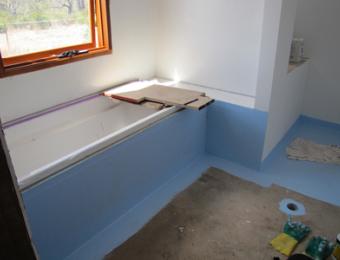
Pre-handover inspections are carried out to make sure everything is working and built to a good standard.
Your house is complete. Everything looks like it’s basically in the right spot, and you’ve been chewing your fingernails down to stumps for the last six months or so in anticipation of moving in. This really isn’t the time to get lazy though…
What is a pre-handover inspection?
The pre-handover inspection of your house is supposed to be your last chance to make absolutely sure that it’s been built exactly the way it was supposed to be built, and that serious issues like compliance with provisions for bushfire safety are met, termite protection is complete and wet area waterproofing is properly installed.
It’s also the time to make sure that the finishing touches are correct – which means ensuring curtain rails are properly secured, that there aren’t any awkward little gaps around your kitchen bench, and that the bases of doors are sealed or that the gaps under your doors aren’t unusually high.
Notice, contract requirements and practical completion
Your builder’s going to be (understandably) keen to put the final stamp on your project and collect the final payment, so this is the time to thoroughly inspect your future home and make sure everything’s exactly as it should be.
Your contract should spell out the handover process. Usually, the builder is required to serve notice when the project reaches what’s known as ‘practical completion’. From that point there are time limits for you to conduct your inspections and report any defects, and for the builder to do the necessary rectifications.
Definitions of what constitutes practical completion do vary, but ‘practical completion’ essentially means the work is complete and fit for purpose, excepting minor omissions and blemishes.
Responsibility for who insures the property, when final payment is due to the builder, and the commencement date of the defects liability period are just some of the post-completion obligations linked to the issue date of the notice of practical completion. It’s an important legal document, so the it’s important that you and your builder both observe the contractual duties it imposes.
Who does the pre-handover inspection?
A lot of people go this alone with a sharp eye, a phone camera and a packet of red-dot stickers – but we’d strongly encourage you to pay a professional building consultant to help with your pre-handover inspection.
You’ll (rightly) feel that you know a lot about the building by the time you reach practical completion. It’s one thing to know your house inside out though – and another entirely to know what the contract documents and acceptable building practices actually require of the builder; to approach the inspection methodically, report your concerns using terminology the builder will have confidence in and be able to act on, and all with the attention to detail it really deserves.
If you’ve been smart, you will have engaged a consultant, before this, to carry out at least one progress inspection during the course of the works. If one only, this inspection should have occurred when the ‘bones’ of the building were exposed (e.g. immediately before installation of the plaster linings, when the roof has been made watertight, all services installed and wall cavities/flashings cleaned). If the works are right at this stage the chances are significantly higher that it will be right at completion.
What gets inspected?
Firstly, you’ll need to provide the consultant with copies of basic contract documents (things like drawings, specification, schedules of finishes, etc.). These will help the consultant to understand what the builder was required to construct. The last thing anyone needs, at this late stage, is a dispute over a reported omission that turns out to not be in the contract.
Let the consultant know if you have any specific concerns about the building. This is an opportunity to get an independent opinion about the seriousness or otherwise of a perceived problem.
A good consultant will test and check things you mightn’t even consider – and they probably won’t have to find much wrong to justify the expense.
With a pre-handover inspection, the whole house gets inspected from top to bottom. Your consultant will check the entire exterior and roof and carry out a room by room inspection of all finishes, fixtures, fittings and appliances.
A pre-handover inspection is significantly different to the mandatory final inspections carried out by the building surveyor working for your council or a private building surveyor (called a Principal Certifying Authority or PCA in NSW). Your building surveyor ensures that construction complies with the BCA, Australian Standards, your state or territory building regulations and that everything’s been built as approved. The building surveyor ensures the building is technically ‘habitable’.
The pre-handover inspection, by contrast, is focused on the completeness and quality of the workmanship, and is concerned with the delivery of exactly what’s been agreed upon in your contract. This includes specified finishes, colours, inclusions, etc. Unless you notify your consultant otherwise, this type of inspection rarely includes things like operating appliances (which often aren’t installed until the day of handover to minimise the risk of theft), running a tape over the building or counting the number of lights and power points.
Getting problems fixed
Once the pre-handover inspection’s complete, the consultant will typically prepare a report, which should include a list of any defects and omissions or certifications you can reasonably expect the builder to provide. This report should be available, within 24 hours, for the builder to review and (where necessary) rectify or to argue their case about whatever’s been presented. It is important to keep communication completely open with the builder at this time, including listening to any reasonable explanations about why something has been done a certain way. Your consultant may assist and advise with regard to these explanations.
Generally, the builder will go through the list and rectify as necessary - or address your concerns about the work that’s been done. Normally the contract will specify a time by which these fixes will be taken care of. At this point you (and your consultant) will re-assess the problem bits. If they’ve been dealt with to your satisfaction the handover of your home should continue without delay. Again, the timing of all these events should be as set out in the contract.
In most instances these issues will be relatively minor, and the builder won’t have any problem just fixing them. Where any significant disagreement still exists, or where the problem can’t easily be fixed, it may be necessary to find an alternative solution or compromise with which both parties can be satisfied.
In the worst case, if an agreement can’t be reached you may need to settle the matter using the relevant consumer affairs organisation in your state or territory, or in court.



